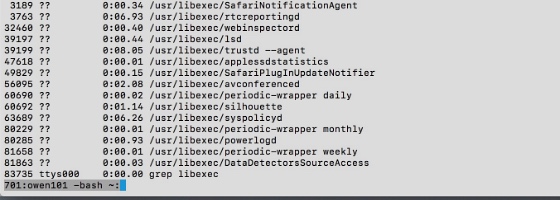
Next Previous (Up to OJB's Tips Page) Basic Terminal StuffTo access the Unix command line you need to run the Terminal utility. For those of you who have never used a command line - its a way of controlling a computer by typing commands instead of pointing and clicking - quaint idea, isn't it? Anyway, let's try it. Run the terminal program and type ls (that's L, not I), then press return. The "ls" command lists the items in the current working directory. If you don't know what this is try typing pwd, then return. Getting the idea? The working directory should be "/Users/yourname" (that means a folder called yourname which is inside a folder called Users, where yourname is the name of your home directory/folder). Now we will look in another directory. Type cd Documents, then press return. Now type ls and return. You will see the contents of your "Documents" folder. Let's find out what programs are running on our machine. Type ps -ax and return. You will see about 50 complicated looking lines. Each line is a different program - many run in the background without the user even knowing. Some are Unix programs, for example "httpd". Some are Mac programs, for example "Finder.app". The "-ax" after the "ps" command is a list of options which modify the basic process status command. The "a" means show all users' processes (programs) and the "x" means show system processes that would otherwise be hidden. There are many options available for the ps command. Type man ps for a list. After each page press space to see the next page or q to quit. The man command shows the manual for a command. ![[Next]](../XuShared/Next2B.jpeg)
![[Up]](../XuShared/Up2B.jpeg)
|
||||||||||||